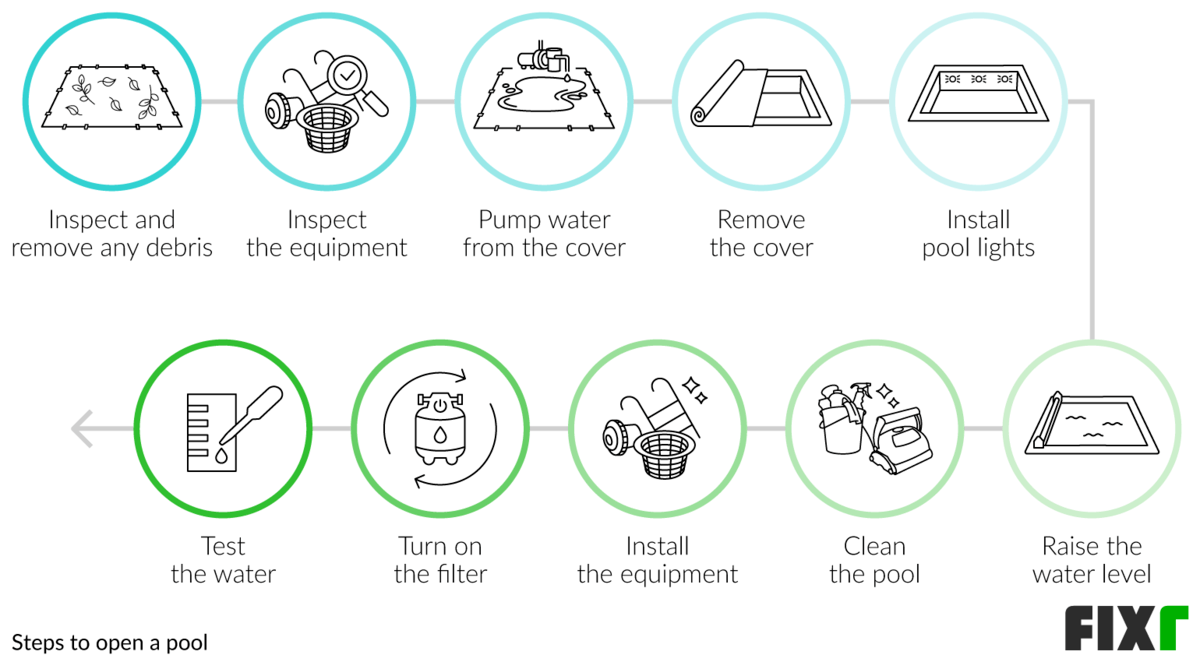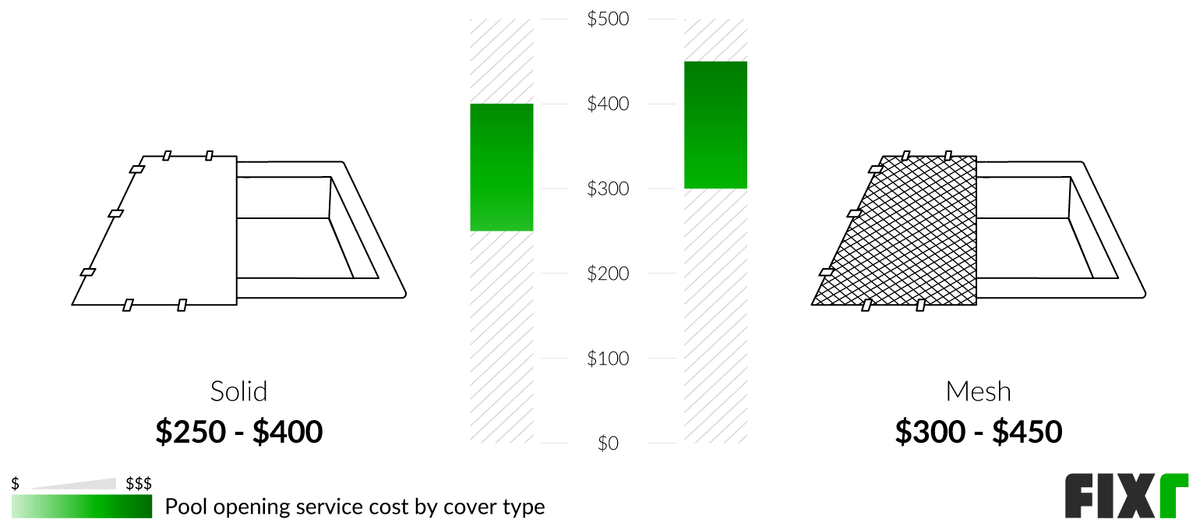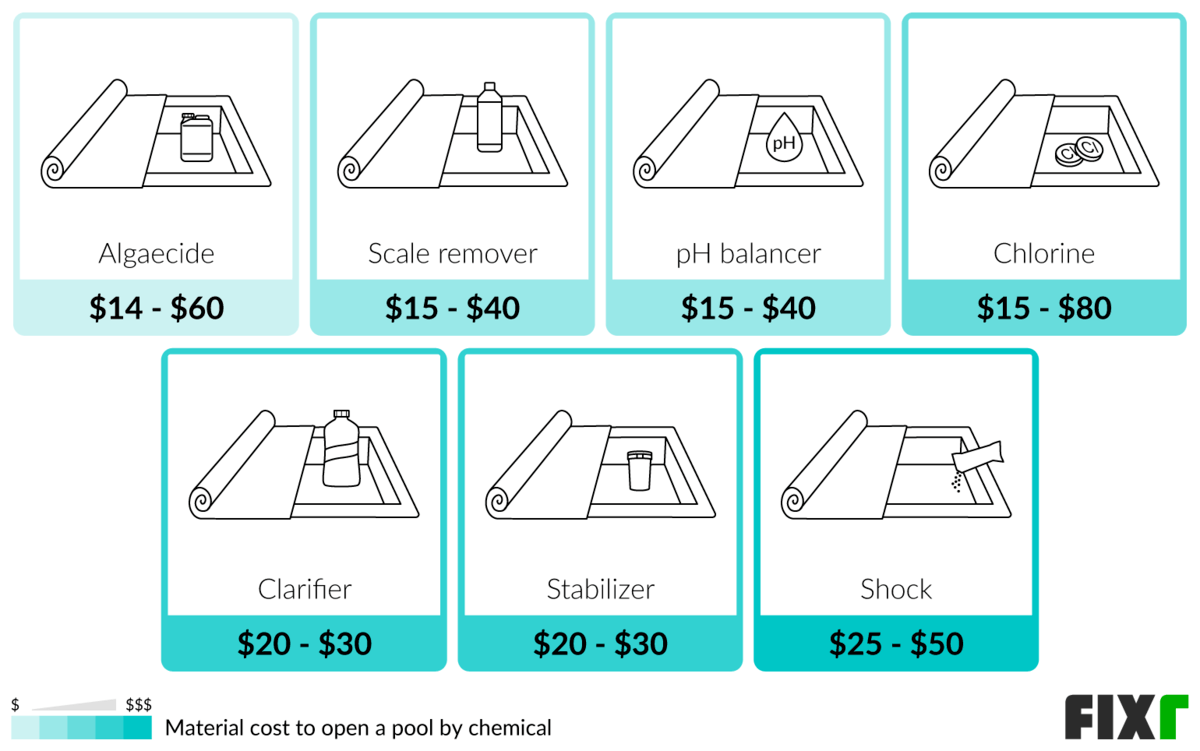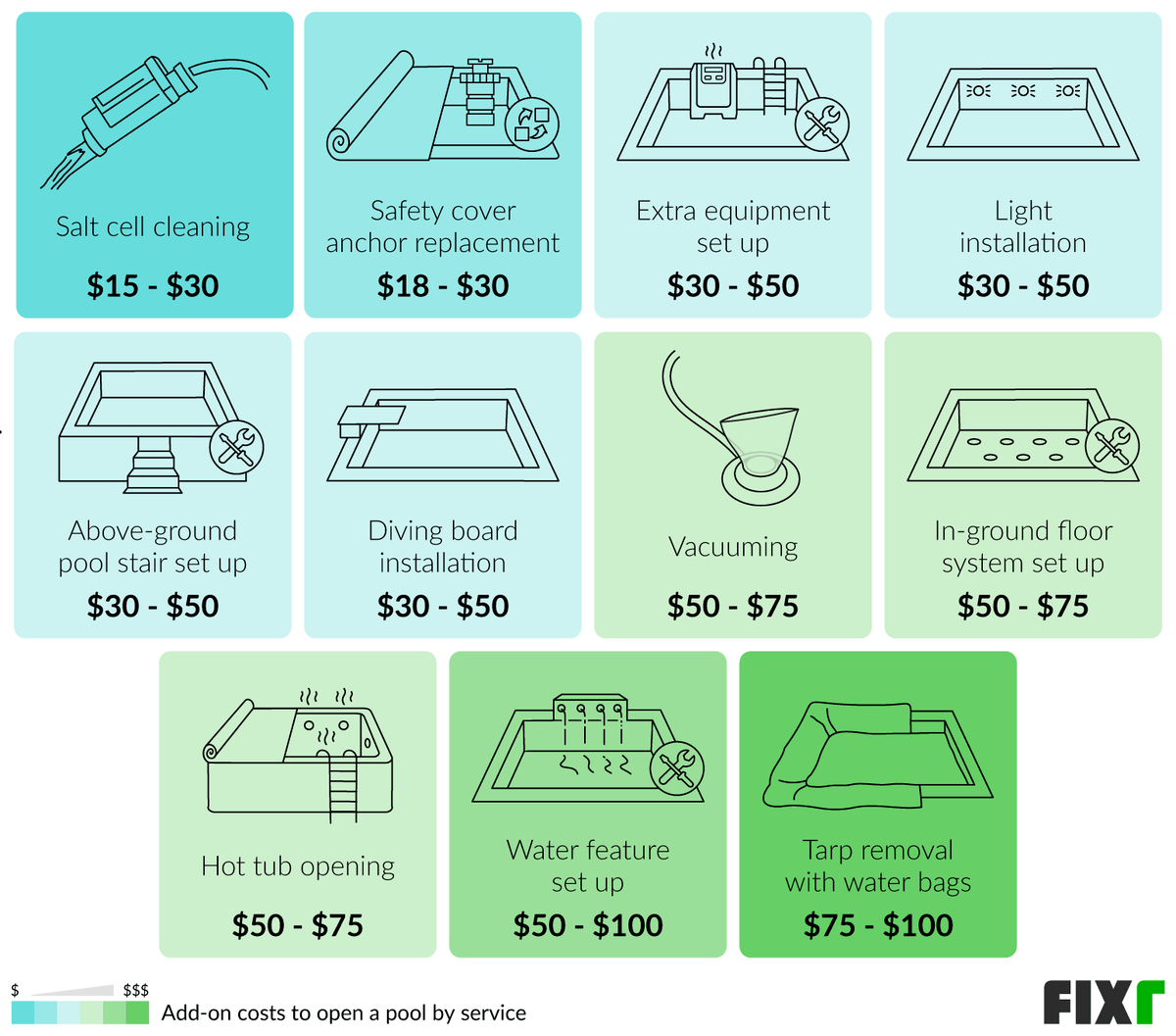How Much Does It Cost to Open a Pool?
If you do not use your pool year-round, you likely winterize and close it for the colder months. When the weather warms up, you want to get your pool ready. This process opens the pool for the season and may be simple or complicated, depending on its condition and how long it has been closed.
The national average cost of pool opening is around $250 to $350, with most homeowners paying $300 for a full opening with cover removal, inspection, and equipment installation. This project’s low cost is $175 for a partial opening of an above-ground pool with equipment installation and chemical testing. The high cost is $500 for full opening with vacuuming, hot tub opening, cover removal, inspection, and equipment installation.
Pool Opening Cost
| Average Cost to Open a Pool | |
|---|---|
| National average cost | $300 |
| Average range | $250-$350 |
| Low-end | $175 |
| High-end | $500 |
Pool Opening Cost by Project Range
What Is Pool Opening?
Pool opening gets your pool ready for the season. If you winterized your pool, meaning you lowered the water level, removed the equipment, and covered it, you need to reverse the process to ready the pool for warm weather.
Every pool company is different in what they offer. Some offer full-service pool openings, including pumping water from your cover, removing the cover, inspecting the pool, filling it with water, installing equipment, and balancing chemicals.
Other companies offer a partial pool opening. You need to remove the cover and fill the pool yourself in these cases. They take care of installing equipment and checking your water balance, but you are responsible for adding water and adding chemicals to get it ready for the season.
Partial pool openings are less expensive because there is less work for the professionals, but there is more work for you. Depending on your comfort level, you can hire a company to handle as much or as little of the process to get your pool ready.
Steps to Open a Pool
Regardless of which pool you have, the steps to open it are generally the same. If your pool has waterfalls, diving boards, hot tubs, or needs vacuuming due to a mesh cover, these are add-on services not covered in a typical pool opening. You need to take care of these separately or contract with the company to handle them at an additional cost. The basic steps to open a pool include:
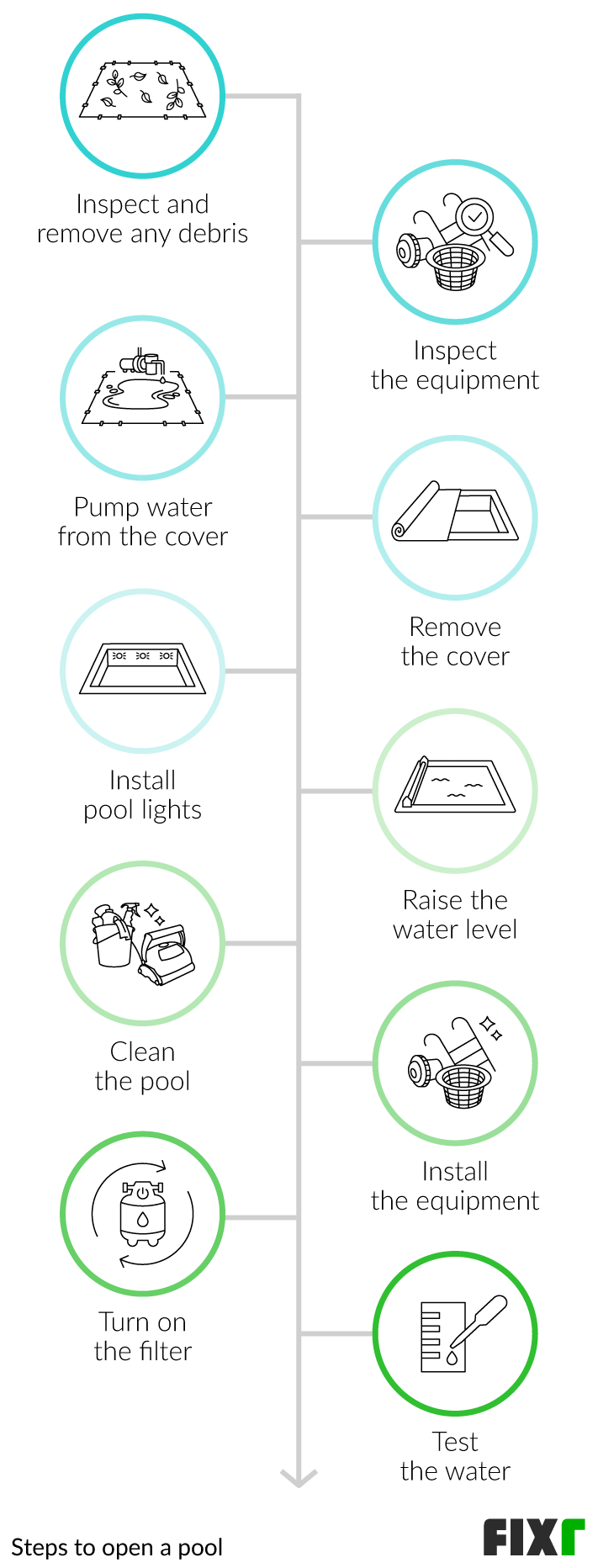
1. Inspect the Area and Remove any Debris
The first step that should be done is to look at the cover and surrounding area. Clear off debris or fallen leaves and inspect the safety cover attachments. Also, make sure the area is ready for the pool to open safely.
2. Inspect the Equipment
Ensure all parts are accounted for, and the equipment is in good condition and ready for installation. Do not attempt to install equipment that is missing parts or in poor condition. Speak to your pool company when in doubt.
3. Pump Water From the Cover
Water may have collected on top if the cover is solid. Run the pool cover pump 1 to remove it so that the cover can be removed. Mesh covers do not require pumping. If you have a mesh cover, nothing additional needs to be done after removing debris and inspecting it for repair.
4. Remove the Cover
Remove the pool cover and rinse it with clean water to remove the dirt. If it is stored, set it out to dry first. Once the pool cover is dry, fold it for storage. If the cover is retractable, make sure it is clean before retracting.
5. Install Pool Lights
If your pool has lights, install the bulbs before raising the water level. Do not turn on electricity until after this step is completed. Inspect the light sockets and do not use them or turn on the electricity if they appear damaged.
6. Raise the Water Level
Use a hose to raise the water level to the waterline. This is about 6” to 18”, depending on how far you dropped the level at closing. You can typically leave the hose for 1 to 2 hours, but this may vary depending on pool size and water flow.
7. Clean the Pool
Remove additional debris from the pool bottom and skimmer openings. If you have a mesh cover, you may need to vacuum the pool. If you notice grime on the sides, wash them to remove it and skim debris.
8. Install the Equipment
Install your pool’s filter, heater, and pump. Turn on the electricity and ensure everything is working properly. You can also install ladders, water features, diving boards, and other equipment at this time.
9. Turn on the Filter
Run the pool filter and pump for a minimum of 12 to 24 hours to circulate the water and remove sediment. This also provides better results for chemical testing. Do not use the pool or agitate it while this is being done. Do not add any chemicals to the pool at this point.
10. Test the Water
Once 24 hours have passed, test the water and adjust the chemicals as needed. Some companies run a water analysis for you. Others may supply you with pool test kits. Ensure the water levels are balanced before using the pool.
Cost to Open a Pool for the Summer by Type
The pool type influences your pool opening costs. The opening processes for different pools are similar but can have variations. Generally, above-ground pools are easier and less expensive to open. Their covers are lighter with less equipment, so it takes less time. In-ground pools are often more complex and have higher opening costs. These are the costs for opening the pool. Additional equipment, hot tubs, or extensive vacuuming due to a mesh cover raises costs.
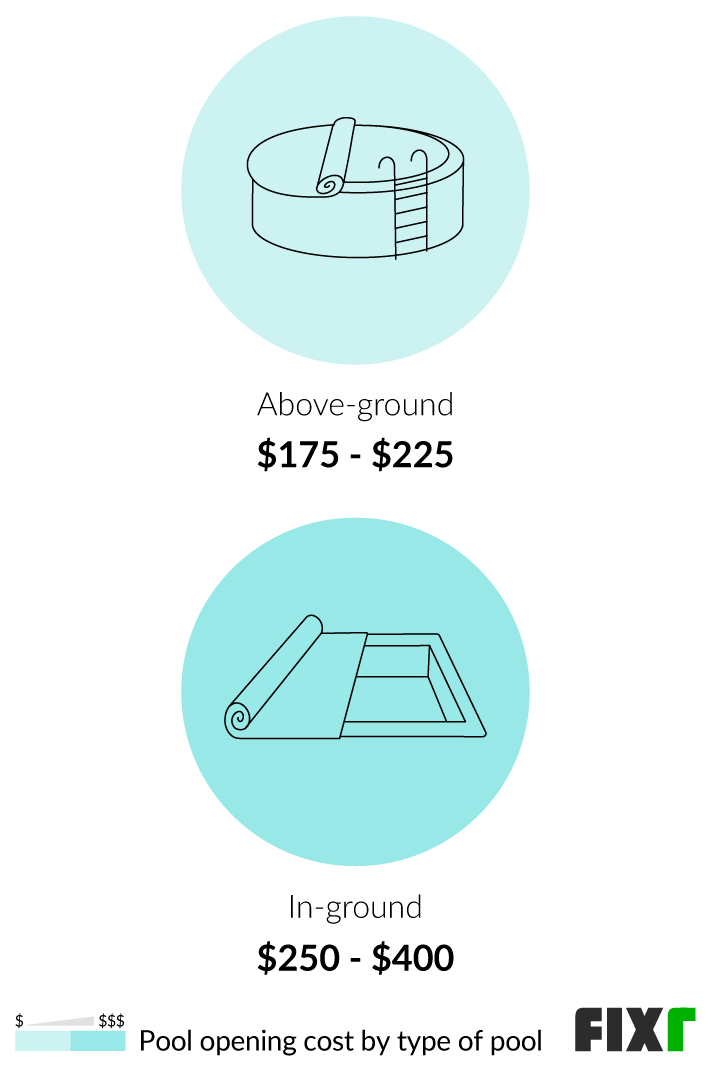
| Type of Pool | Average Costs |
|---|---|
| Above-Ground | $175 - $225 |
| In-Ground | $250 - $400 |
Cost to Open an Above-Ground Pool
Opening an above-ground pool ranges from $175 to $225. Above-ground pool openings are nearly identical to in-ground pool openings. Because they tend to be smaller, they do not require the same chemicals or as much time to fill or allow the water to circulate. They also tend to have lighter, easy-to-remove covers that may not require pumping. For this reason, they are less expensive to open than an in-ground pool. Because they are simpler, partial openings are rare, but you can have someone install the equipment and nothing else for a lower cost in some cases. If your above-ground pool has lights or special equipment, you may have additional costs.
Cost to Open an In-Ground Pool
Opening an in-ground pool costs between $250 and $400. In-ground pools have a range of costs depending on the level of need and how many pieces of equipment. For example, mesh covers do not require pumping but may require more cleaning. Pools with lights or additional equipment take longer and cost more to open. There may also be a small upcharge for chemicals if your pool is large. Some companies offer partial openings to keep costs down because opening in-ground pools is complex.
Pool Opening Service Cost by Type of Cover
When your pool is closed for winterization, part of that process involves covering it. Pool covers keep debris out and prevent people or pets from falling in. While there are many different covers, only two distinctions influence your pool opening costs: solid and mesh covers. Your covers may be manual or retractable, but these factors do not influence costs like the cover material.
Solid covers are considered the default, and cover pumping, removal, rinsing, and storage are included in full-service pool openings. Mesh covers do not require pumping because water from snow and rain can enter the pool through the mesh. However, a mesh-covered pool can grow algae if exposed to enough sunlight or the chemical balance is off. In addition, mesh-covered pools allow debris to enter the pool. Mesh-covered pools need to be vacuumed and potentially require additional chemicals. For this reason, opening a pool with a mesh cover generally costs more than opening a pool with a solid cover. Otherwise, the pool opening process is identical. Below are the average costs to open a pool based on the cover type.
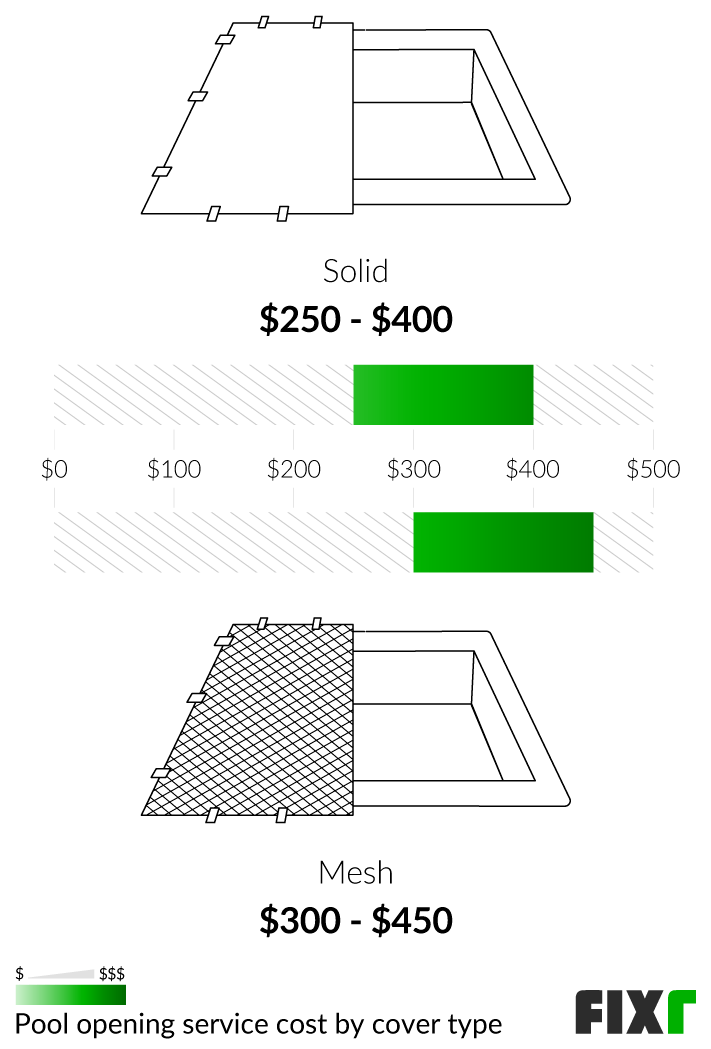
| Cover Type | Average Opening Costs |
|---|---|
| Solid | $250 - $400 |
| Mesh | $300 - $450 |
Cost of Chemicals for Pool Opening
Part of opening your pool is testing the chemicals and balancing them. Your pool company does this in a full pool opening. However, you are responsible for testing and adding necessary chemicals in a partial opening. Some companies offer a computer-aided test where you bring in a vial of the pool water for analysis if they do not balance the chemicals.
Regardless, there may be a range of chemicals needed for your pool opening. This varies depending on the cover type and the water’s state. For example, pools with a mesh cover may need algaecide upon opening, while pools with solid covers may not. Below are the various chemicals you may need for your pool opening and their average costs.
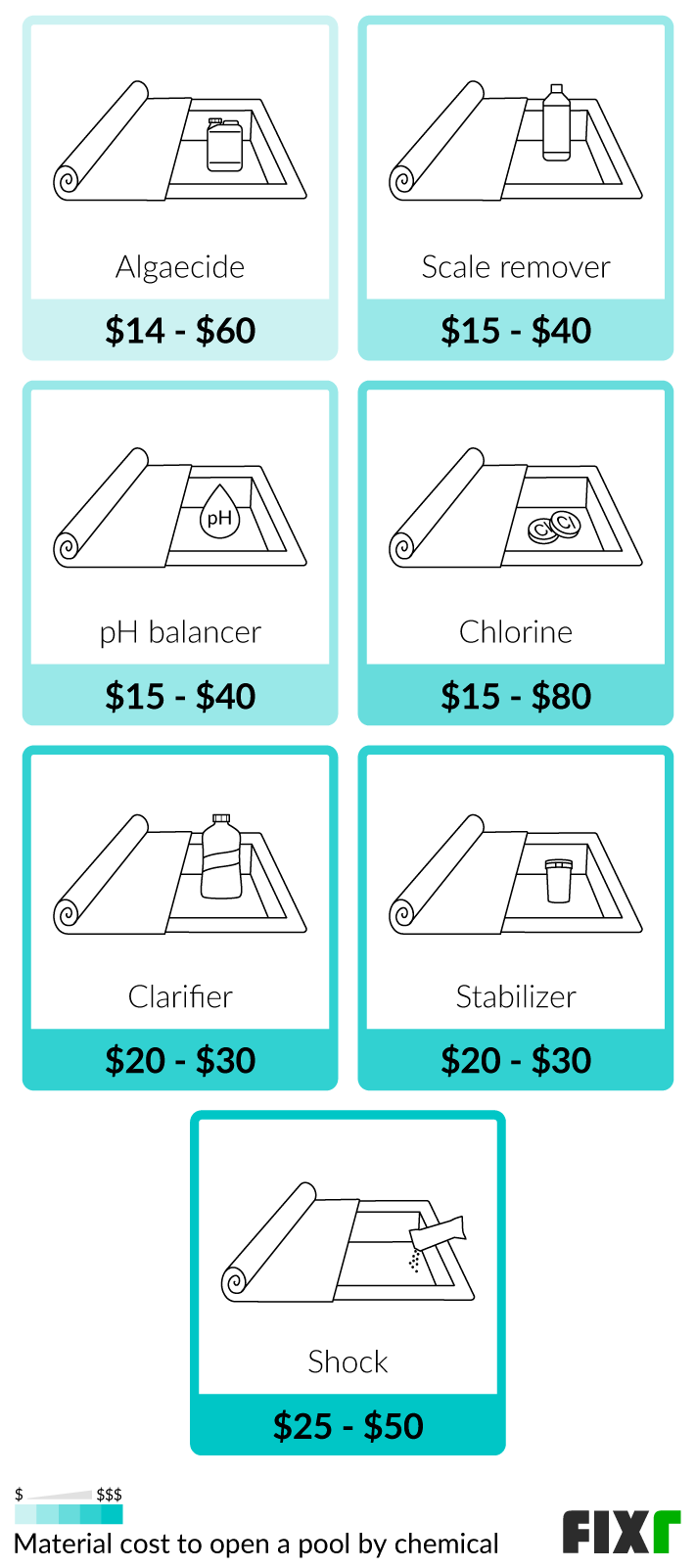
| Chemical | Average Costs (Chemicals Only) |
|---|---|
| Algaecide | $14 - $60 |
| Scale Remover | $15 - $40 |
| pH Balancer | $15 - $40 |
| Chlorine 2 | $15 - $80 |
| Clarifier | $20 - $30 |
| Stabilizer | $20 - $30 |
| Shock | $25 - $50 |
Pool Opening Add-On Costs
While a full pool opening can get a basic pool up and running and ready for the season, additional pool features are not included in the basic price. This includes vacuuming, setting up specialty equipment, setting up water features, installing lights in the pool steps, and opening your hot tub. Some costs like the pool vacuuming cost may be added based on the cover type and equipment. You may need to specifically ask for other things, such as setting up a pool ladder on your above-ground pool or reinstalling a diving board.
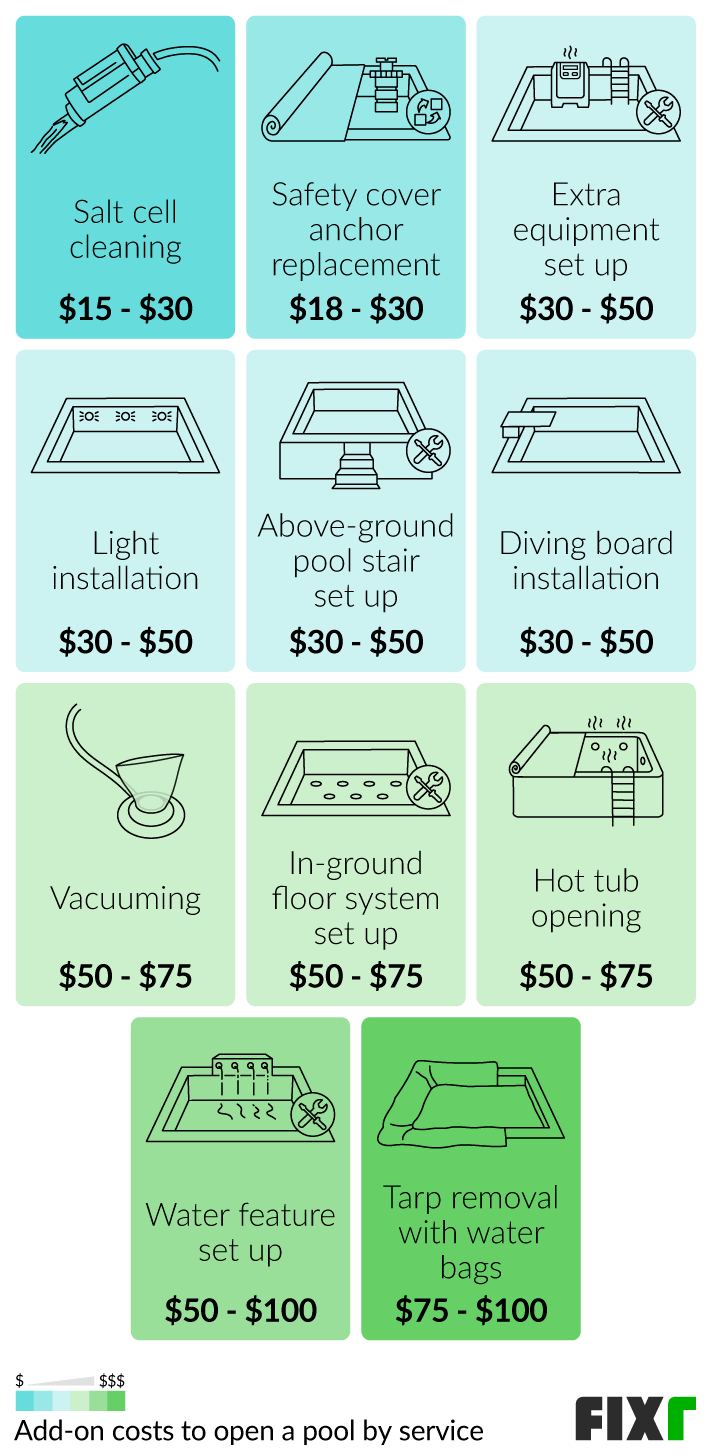
| Add-On | Cost |
|---|---|
| Salt Cell Cleaning | $15 - $30 |
| Safety Cover Anchor Replacement | $18 - $30 |
| Extra Equipment Set Up | $30 - $50 |
| Light Installation | $30 - $50 |
| Above-Ground Pool Stair Set Up | $30 - $50 |
| Diving Board Installation | $30 - $50 |
| Vacuuming | $50 - $75 |
| In-Ground Floor System Set Up | $50 - $75 |
| Hot Tub Opening | $50 - $75 |
| Water Feature Set Up | $50 - $100 |
| Tarp Removal With Water Bags | $75 - $100 |
Cost of Opening and Closing a Pool
Many pool companies open and close your pool. Working with the same company for both can often streamline the process. Using a single company means this company knows what equipment you have, what condition it is in, where it is kept, and how it is installed. This can make the process smoother on both ends. The cost to close a pool is $200 to $300, while the cost of opening is $250 to $350, making total yearly costs $450 to $650 for full opening and closing. You can lower your costs by opting for partial service and doing some work yourself.
Enhancement and Improvement Costs
Cost of an Automatic Pool Cleaner
Robotic pool cleaners help keep your pool cleaner all summer long. They can also be deployed at pool openings to remove debris and eliminate extra vacuuming that may be required for pools with mesh covers. Pool cleaners are small robots that vacuum your pool floor like a robot vacuum takes care of your home. They cost $500 to $1,000, depending on the size and features.
Additional Considerations and Costs
- Time to open. Unless your pool was in poor condition, missing a cover, not closed properly, or closed for a significant period, it is likely ready for use in 1 to 2 days for above-ground pools and in-ground pools with a heater. Some large in-ground pools may need a few additional days to warm, while saltwater pools need an extra day to filter.
- Maintenance and repair. Pool opening is a small part of pool maintenance. Many other duties can keep your pool in condition and ensure the water is safe. Bacteria, viruses, and other pathogens build without proper maintenance, including daily and weekly pool treatment. This can put pool users at risk, and the water can also get dirty if the pool is not cleaned often. Pool owners can do many tasks or bring in a professional maintenance company. Pool maintenance costs $90 to $270 for the summer, but you can have higher costs if your pool has special needs. If structural issues are uncovered when you open your pool, you need to address them. Typical pool repairs cost around $900.
- Cement pool opening. If you have a cement or gunite pool, open it sooner, at the start of the season when temperatures remain above 64º F. This is to balance the pool’s pH because your water leaves deposits on the concrete with a too high level. Water that is too low in pH pulls what it requires from the concrete or grout 3, causing tiles to fall off.
- Opening an unmaintained pool. If your pool has been closed for years, prepare for a longer process. It needs an inspection and possibly repairs if it has not been maintained. Expect an opening to cost at least $500, more if repairs are needed.
- Pool chemical safety. Pool chemicals can cause burns or poison the user. These injuries often occur when the person handling the chemicals does not wear protective gear. Always protect your eyes and use other necessary precautions when handling pool chemicals.
- DIY. Many people open and close their pools. The process is the same. You may want to test your pool water professionally before and after balancing to ensure it is safe.
- Saltwater pools. Opening is the same for a saltwater pool, but you need to test the water’s salinity and balance and install the salt cell. This can add $20 to $30.
FAQs
- What month should I open my pool?
This depends largely on where you live, but most people can open their pool in May or June. You may be able to open it sooner in warmer climates.
- How long after opening a pool can you swim?
Typically, experts recommend waiting 1 to 2 days after opening the pool and applying chemical treatments before swimming.
- How much shock do I need to open my pool?
Usually, 3 bags of chlorine are necessary to shock a pool. This varies by volume, however, so consult your pool company for the most accurate amount.
- What chemicals are used to start up a pool?
The chemical selection varies from pool to pool but usually consists of a scale remover, shock, pH balancer, chlorine tablets, stabilizers, and algaecides. Purchase a test kit to find out what your pool needs.
- What is included in a pool opening?
There are two types of pool opening - partial and full. In a partial opening, the equipment is installed, but nothing else is done. In a full opening, the cover is pumped and removed, the water added, equipment installed and inspected, and the chemicals are added.
- Do you have to open your pool every year?
No, but if you do not, inspect it to ensure it can safely go another year.
- How much does it cost to open a pool for the summer?
The average cost is $250 to $350, depending on the pool type and area.
Remodeling Terms Cheat Sheet
Definitions in laymen's terms, cost considerations, pictures and things you need to know.See full cheat sheet.
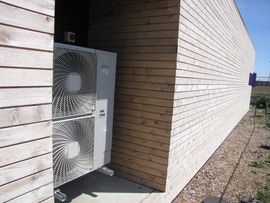 1 Pump: A device used to move air, liquid, or gas by mechanical means
1 Pump: A device used to move air, liquid, or gas by mechanical means
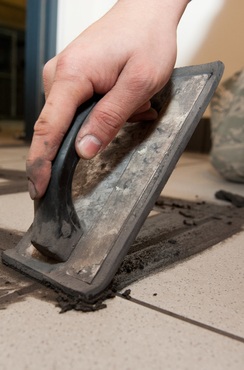 3 Grout: A fluid form of cement used to seal the joints between tiles. It also makes the surface stronger because it bonds the tiles together
3 Grout: A fluid form of cement used to seal the joints between tiles. It also makes the surface stronger because it bonds the tiles together
How much does it cost to open a pool in my city?
Cost to open a pool varies greatly by region (and even by zip code). To get free estimates from local contractors, please indicate yours.

